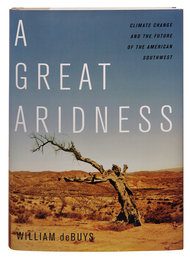The Southwest, with its delicate desert ecology is even more susceptible to strain than other regions of the West. There are particular issues to the West that I am focused on: the intersections of ranching, wide open spaces, cowboy and freedom myths, concepts of wilderness, phenomena that encompass both acreage and lifestyle and are foundation to the image of America, but also some of our important resources including energy, ecology, and identity. I am witnessing all of these overlapping strains right now in the Gila: large scale fires; escalating tensions between ranchers and a variety of grassland and riparian conservation initiatives including any species protected under the Endangered Species Act; and of course, the motherlode issue which seems to contain all the others: wolf reintroduction vs cattle ranching.
There is a new (Dec 2011) book out by William deBuys: A Great Aridness: Climate Change and the Future of the American Southwest. deBuys posts about his book here. An excerpt:
“The news for the Southwest is not good: the droughts, fires, social strains and other stresses that lie ahead will challenge the region to the utmost. But the stories about how people came to understand those problems are endlessly fascinating, at least for me. In A Great Aridness I have tried to capture the “eureka moments” when the researchers I talked with glimpsed new and resonant insights – like when Tom Swetnam, who heads the Laboratory of Tree-Ring Research at the University of Arizona, and Julio Betancourt of the USGS made the link between forest fire frequency and the El Nino/La Nina cycle. Or when Mark Varien of the Crow Canyon Archaeological Center found a great kiva at Sand Canyon Pueblo and was able to visualize in a completely new way the pueblo’s final days. Or when Chris Milly or Richard Seager, separately, realized that their climate models were telling them something big.
The surprise for me in writing the book was to come full circle back to issues I had been working on for many years. Yes, we urgently need to cut back on greenhouse gas emissions, which for virtually all of us means a radical change in the way we live. But we also need to take care of business that has long been unfinished, like living within a sustainable water budget and restoring fire resilience to our forests. Climate change only makes more urgent the big task that has always been before us: to learn how to live in the marvelous arid lands of this continent without further spoiling them. It is an old challenge. We have already had a lot of practice, and we should be better at it. We can be.”
In Dec 2011, The New York Times reviewed deBuys’ book and another book by Andrew Ross, Bird on Fire.
An excerpt:
“Dr. deBuys puts it somewhat differently. History teaches that people have difficulty adapting to prolonged, extreme drought, he writes. Faced with it, they typically abandon efforts to cope and simply abandon their homes. That is why we call dry places deserts — they are deserted.
Is that tactic likely for today’s Southwest? No. But, he writes, any answers to the water challenge will require “strong social will and collective commitment.”
At the moment, though, the region’s politics tend to embrace the idea that collective action of any kind is inherently suspicious or even evil; government is the problem, never the solution; and regulation is the bane of economic growth.
These ideas are not in accord with Dr. deBuys’s prescription, which is to “get on with what we should have been doing all along, including limiting greenhouse gases.”
There is no silver bullet, he writes. “There is only the age-old duty to extend kindness to other beings, to work together and with discipline on common challenges.”
Dot Earth post about the book
NY Times post about the book.
Follow up:
Ari Phillips’ 2012 research project, Energy and Climate Change in the American Southwest
